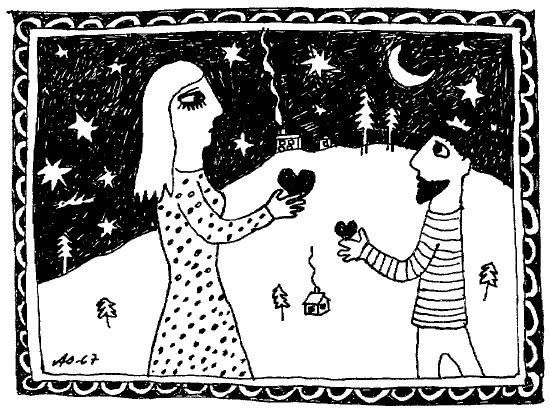Light songs and dark
4 August 2014 | Authors, Reviews

Aulikki Oksanen. Photo: Laura Malmivaara
On my wall at home are paintings given to me by the artist and poet Aulikki Oksanen. A watercolour from 1966 is a stylised depiction, a little in the manner of Modigliani, of a room with a girl by the window. In the background are a harbour and ships.
The work reminds me of the time when I got to know Aulilkki when we both moved in University Theatre circles and I visited her in the room shown in the painting. The flat was later the scene for Lapualaismorsian (‘Lapua bride’), a film which Aulikki (born 1944) took part in.
To me, with her blond, straight hair, she was like a beautiful, slender young filly, so I was not in the least surprised when her debut work included some enchanting horse symbolism. Her first book, an original, fresh collection of poems entitled Hevosen kuolema (‘Death of a horse’, 1966) gained immediate attention.
The musical, corn-blonde young woman was a multitalent who gained her spurs as a writer and poet, an artist, a singer and songmaker, even as a film star. But writing and literature seemed to be at the heart of her world. As a writer she found herself addressing feminism; after all, this was a time when the role of women was being discussed passionately and in a new way.
In one of Aulikki’s works which is in my possession, Madonna and child, the ‘child’ nestling against the mother’s middle is in fact, when you look closer, an adult, tiny, big-nosed man. The painting appears to show a disproportioned loving couple. Some time later Aulikki published her successful novel Tykkimiehen syli (‘The gunner’s embrace’,1968), a story of extremely difficult love. The book made her famous. The work was, in the opinion of a Swedish critic, as fresh in the context of the predominant Finnish realism as a lone cornflower in a field of rye.
Just such a field, with a grey barn and a couple of birch trees, appear in one of Aulikki’s small watercolours, in which the eye can just make out a pair of lovers hidden in the meadow. The watercolour is like an illustration to the songs which Aulikki was writing at the time. Among the finest of these are Puhu minulle rakkaudesta (‘Speak to me of love’), Hyvästi (‘Farewell’) and Sinua, sinua rakastan (‘You, you do I love’), that poem expressing simultaneously extreme suffering and extreme tenderness – has been voted the most touching Finnish love song.
Niin liikkuu pehmeä kätesi / kuin vene varhain aamuisella joella.
Like a boat on an early morning river / moves your soft hand.
The individual seeks his or her place in the world at a time that falls between the twentieth and thirtieth years of life. For us it marked an impassioned period, the cultural radicalism of the 1960s, when earlier values and ways of life were questioned. Life was extremely concentrated and pulsating. A huge amount of happenings and actions were contained in a single year. We knew no fear – there was no time even to consider such a thing. We provoked irritation and sometimes bloodthirsty spleen, but also admiration and gratitude when our contemporaries in Finland felt themselves to have been liberated from something heavy, outdated and stifling. Widely listened to, Aulikki’s songs were inspirational. At that time we began to be conscious of the world beyond the borders of Finland and even of Europe. The Vietnam War and the Third World fluttered before our eyes like a quickly opened fan.
Aulikki Oksanen’s poetry has become widely known as song lyrics. Her poems have been set to music above all by Kaj Chydenius, Henrik Otto Donner and Eero Ojanen, as well as Kerkko Koskinen and Tuure Kilpeläinen, composers of a younger generation. Aulikki herself has also written music for some of her poems.
The collection Helise taivas! Valitut runot 1964–2014 (‘Ring out, heavens! Selected poems 1964–2014’) demonstrates the breadth of the themes and techniques that have welled up in her work over the decades. The stylistic features range from one extreme to the other, from light songs to dark, fateful ballads and symbolic poetry. Sometimes the poems follow the rhythms and imagery of folk songs or pop songs (although they also wilfully vary them), sometimes the moving, unbroken rhythm, moving from one verse to the next, seems to well up directly from the innermost being of the author. The tone varies from shout to whisper, from battle-song to intimate lyrics, from world and universal catastrophe to homely warmth and intimacy.
As time goes by fiery, possessive love can become a fragile, tender image of two old apple trees, leaning against each other, and direct accusation of the wrongdoers of the world can become an exhortation to the heavens to throw the crystal chandeliers of its starry head towards the darkness so that even time might be ashamed of itself.
Translated by Hildi Hawkins
Extracts from the preface to Helise, taivas! Valitut runot 1964–2014 (Siltala, 2014), entitled ‘Aulikki Oksanen, lintunainen’ (‘Aulikki Oksanen, birdwoman’)

Illustration: Aulikki Oksanen
Tags: poetry
No comments for this entry yet
Leave a comment
-
About the writer
Marja-Leena Mikkola (born 1939) is an author and translator who has written song lyrics, short prose, children's books, poetry, television plays and novels. She has translated poetry, from Russian, English and Italian, by authors including Anna Ahmatova, Osip Mandelstam, Boris Pasternak, Sylvia Plath, Dylan Thomas and William Shakespeare. Her work has appeared in in eight languages.
© Writers and translators. Anyone wishing to make use of material published on this website should apply to the Editors.
